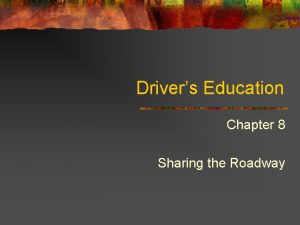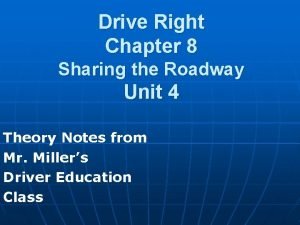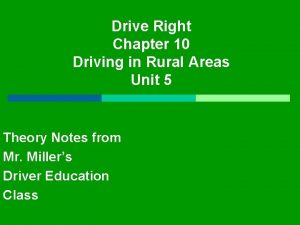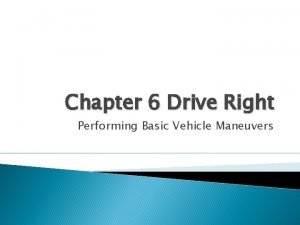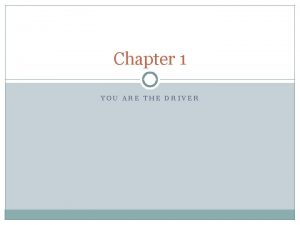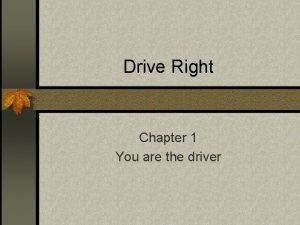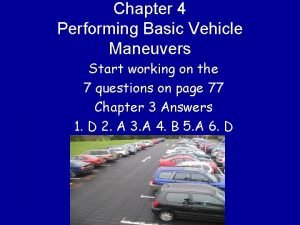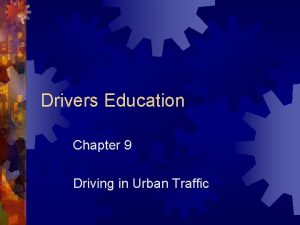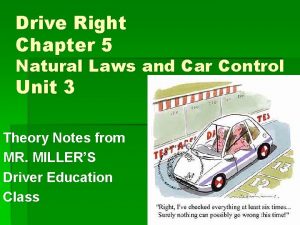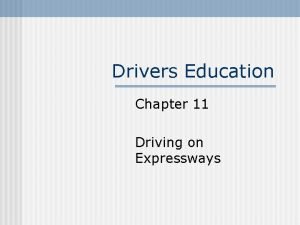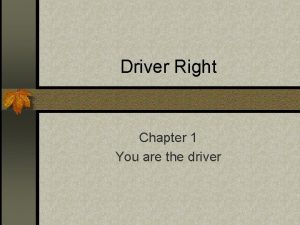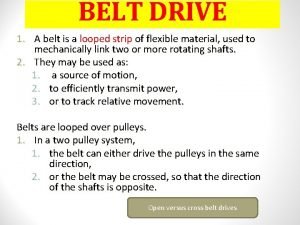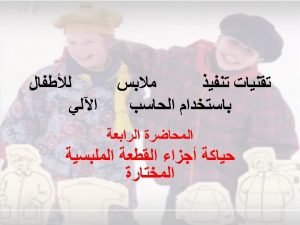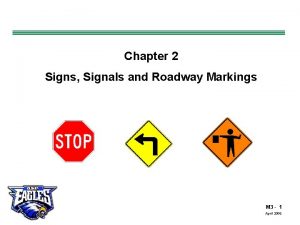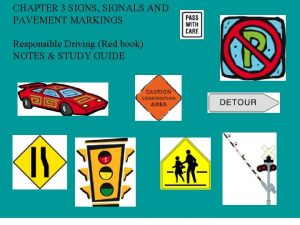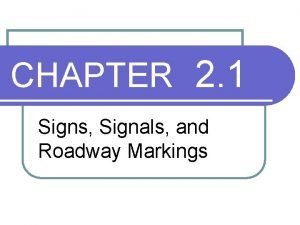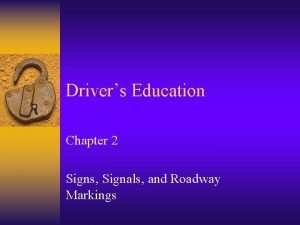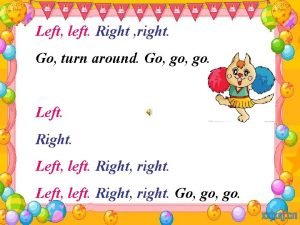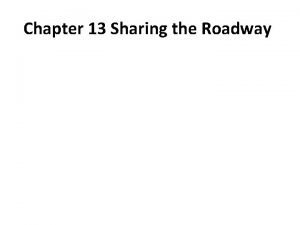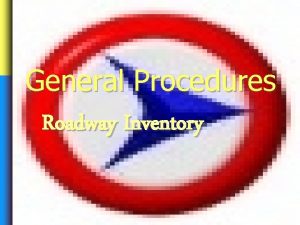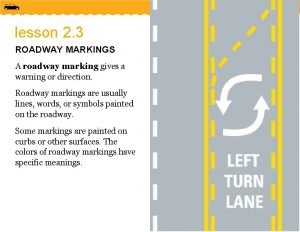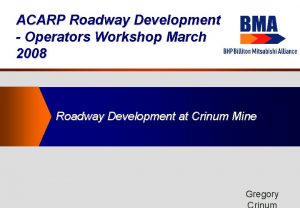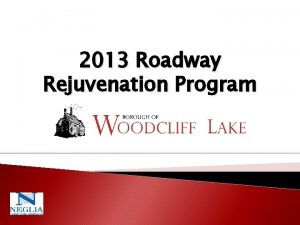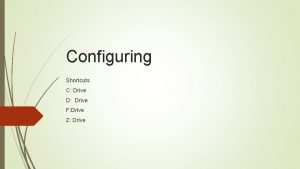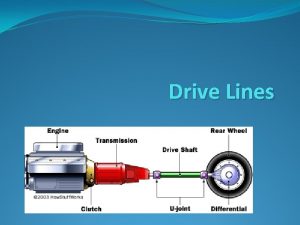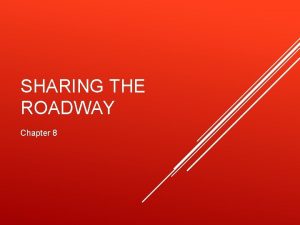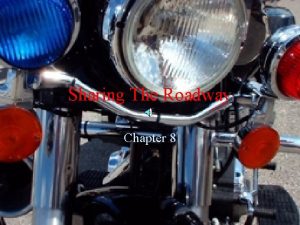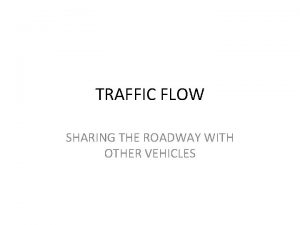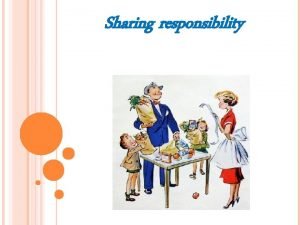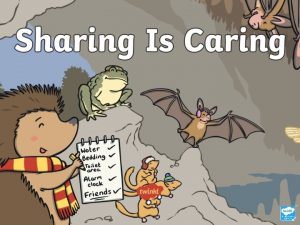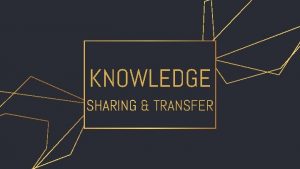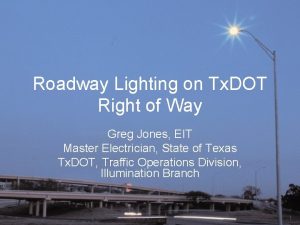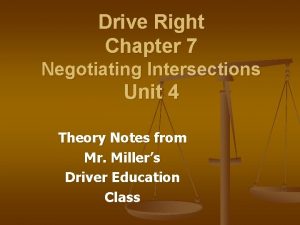Drive Right Chapter 8 Sharing the Roadway Unit













































- Slides: 45

Drive Right Chapter 8 Sharing the Roadway Unit 4 Theory Notes from Mr. Miller’s Driver Education Class

8. 1 Sharing the Roadway with Motorcycles • Motorcyclists have the same privileges within the HTS as drivers of other vehicles. • They also share an equal responsibility for following safe driving practices. • Even though motorcycle registrations make up a very small percentage of vehicle registrations, about 2, 000 cyclist fatalities occur each year. • As a driver of a larger vehicle we must assume much of the responsibility.

8. 1 Sharing the Roadway with Motorcycles • Motorcyclists are often not identified in time to prevent conflict. • Make a special effort to use the IPDE process when identifying motorcyclists. • The identify step is crucial for drivers because motorcycles are more difficult to see. • Predict actions of motorcyclists that might enter your path. • Base your decisions on the problems that confront the motorcyclist, and execute your actions.

8. 1 Sharing the Roadway with Motorcycles • Look for motorcyclists in the following situations: • Vehicle turning left in front of motorcycle. • Vehicle turning right in front of motorcycle. • Motorcyclist turning left. • Motorcyclist in driver’s blind spot. • Tailgating motorcyclist. • Motorcyclist passing vehicle on right or left. • Motorcyclist meeting an oncoming vehicle.

8. 1 Sharing the Roadway with Motorcycles • Passing a Motorcyclist • Never tailgate a cyclist before passing. • When you plan to overtake and pass a motorcyclist, stay well back until you start to pass. • When the way is clear, execute your passing maneuver. • Use the entire left lane for passing. • When you can see the cyclist in the rearview mirror, signal, check your right blind-spot area, and return to the right lane.

8. 1 Sharing the Roadway with Motorcycles • Protecting Motorcyclists • A motorcyclist is fully exposed to dangers that could cause injury or death. • Develop an attitude of helping others who are less protected. • Make it your responsibility to demonstrate habits and behavior that show you care for the safety of your fellow roadway users. http: //www. youtube. com/watch? v=Kxx. G 2 guv. YLw

8. 1 Sharing the Roadway with Motorcycles • Motorcyclists Can Lack Experience and Skill • Be alert when approaching a cyclist. • Predict judgment and control errors due to inexperience and lack of skill. • Some may be on borrowed or rented motorcycles. • Some may not have received proper riding instruction.

8. 1 Sharing the Roadway with Motorcycles • Handling Traits of Motorcycles • Help protect motorcyclists by being aware of the handling traits of motorcycles and how they operate. • Control of a motorcycle is difficult in a turn or sharp curve. • The cyclist can have even more difficulty in a sharp turn or sharp curve. • The cyclist can have even more difficulty handling the cycle in a strong wind, or if the roadway is rough or slippery.

8. 1 Sharing the Roadway with Motorcycles • Increase Your Following Distance • A motorcyclist’s balance and stability depend on two small areas of tires that grip the roadway. • Water, sand, oil, wet leaves, potholes, or loose gravel reduce traction and can make motorcycle control even more uncertain.

8. 1 Sharing the Roadway with Motorcycles • Make the Motorcyclist Aware of You • Don’t tailgate a motorcyclist. • Traffic, noise from the motorcycle and wind make it difficult for a cyclist to hear. • Helmets also muffle the sound and make it difficult to hear. • Small mirrors on the handlebars and the vibration of the motorcycle can restrict the view to the rear. • Keep extra space in your front zone when you think a cyclist is unaware of your presence.

8. 2 Motorcyclist Actions Can Affect You • How motorcyclists Ride • Motorcyclists need to develop safe driving skills. • All states offer motorcycle safety courses taught by instructors certified by the motorcycle Safety Foundation. • Proper training and helmet use has reduced motorcycle fatalities. • With proper instruction and training – and an attitude of responsibility and caring – motorcyclists can become cooperative, low risk users of the HTS.

8. 2 Motorcyclist Actions Can Affect You • Braking and Accelerating • A vehicle driver needs to only step on the foot brake to stop a vehicle. • A motorcyclists must operate separate brakes for the front and rear wheels. • A cyclist must coordinate the hand throttle, hand clutch, and foot-gear shift lever to accelerate. • Balance problems can occur if these actions are not coordinated.

8. 2 Motorcyclist Actions Can Affect You • Loss of Balance • A motorcycle is more difficult to remain upright while in motion. • This especially rough if the roadway is wet or covered with oil drippings.

8. 2 Motorcyclist Actions Can Affect You • Following Distance • Motorcyclists should increase their following distance to reduce risk of collision. • Increased following distance also helps prevent cyclists from being hit by pebbles or dirt thrown. • Check your rearview mirror often. • Be aware of following motorcyclists, and avoid making sudden stops.

8. 2 Motorcyclist Actions Can Affect You • Use of Protective Equipment • Motorcyclists must make every effort to protect themselves. • Helmets are required in many states • Cyclists can reduce or prevent injuries by using protective equipment. • Helmets • Eye-protection • Heavy shoes or boots • Full-length pants and jacket • Full-fingered gloves

8. 2 Motorcyclist Actions Can Affect You • Special Riding Problems • Weather and roadway conditions present greater problems to cyclists than they do to drivers of other vehicles. • Allow extra time and space for motorcyclists in all adverse weather conditions. • Leave extra space for motorcyclists who are crossing railroad tracks or carrying passengers.

8. 2 Motorcyclist Actions Can Affect You • Adverse Weather Conditions • Motorcyclists obviously cannot cope with adverse weather conditions as well as a driver in a four-wheel vehicle can. • A simple pothole beneath a puddle can cause a motorcyclist to be thrown out of control. • The lines on a roadway often become very slippery when it begins to rain.

8. 2 Motorcyclist Actions Can Affect You • Motorcyclist Crossing Railroad Tracks • Railroad tracks are a special problem for motorcyclists. • Motorcycle tires can get caught in the grooves of the crossing, causing the motorcyclists to lose balance. • A cyclist should cross railroad tracks as close to a right angle as possible, as long as this does not cause the cyclist to enter another lane.

8. 2 Motorcyclist Actions Can Affect You • Motorcyclist Carrying Passengers • A motorcycle carrying two passengers requires extra caution from other vehicle drivers. • Be alert for a difference in acceleration, braking, and turning when a motorcyclist is carrying a passenger. • A passenger can create balance and control problems for the cyclist by leaning the wrong way in curves and turns.

8. 2 Motorcyclist Actions Can Affect You • How Motorcyclist Can Help Other Vehicle Drivers • They should use all of their skills and techniques to reduce their risks of conflicts. • Nothing the cyclist does should diminish the caution other drivers must practice near motorcyclists. • You must always be ready to yield to cyclists.

8. 2 Motorcyclist Actions Can Affect You • Riding in Groups • Motorcyclists often travel in groups. • When you see one cyclist, be prepared to see others. • Cyclists should not ride side by side in traffic. • They should be in an offset position. • It is easy to see cyclists if they ride in an offset position. • It allows them to swerve safely. • Prepare for cyclists to change lanes before turning.

8. 2 Motorcyclist Actions Can Affect You • Being Visible in Traffic • A rider in the correct position is visible to the driver ahead as well as to oncoming drivers. • This provides a degree of safety to the passing maneuver. • It also reduces the chance that the cyclist will be forced off the roadway. • Motorcyclists should not ride between lanes of moving vehicles. • In many states this is illegal.

8. 2 Motorcyclist Actions Can Affect You • Riding at Night • It is far more difficult for drivers of other vehicles to judge the speed and position of a motorcycle at night. • Because a motorcycle’s taillight is relatively small, drivers behind may have difficulty seeing it. • Motorcyclists should take extra effort when riding at night. • They should make every effort to make themselves more visible.

8. 3 Bicycles, Mopeds, and Motor Scooters • Bicycles and low-powered, two wheel vehicles continue to be popular for transportation, recreation and business. • Users of smaller two wheel vehicles have the same privileges and responsibilities as other drivers. • They must use the same IPDE process as all other roadway users. • Drivers of larger vehicles must accept the major responsibility for avoiding conflict.

8. 3 Bicycles, Mopeds, and Motor Scooters • Bicyclists’ Responsibilities • Be a responsible bicyclist by following these safe riding practices: • Wear a helmet for protection • Know and follow the laws regarding roadway riding, lane position, and sidewalk riding. • Obey all signs, signals, and laws. • Wear light colored clothing and have lights and reflectors on bicycle when riding at night. • Do not wear earphones while bicycling. Wearing earphones while bicycling or driving a motor vehicle is illegal in many states. • Keep bicycles in safe operating condition. http: //www. youtube. com/watch? v=mg. Ka. S 0 w 8 zc. A

8. 3 Bicycles, Mopeds, and Motor Scooters • Protecting Bicyclists • Give bicycles extra space whenever possible. • Be aware of possible paths the bicyclist may take. • Vehicle doors opening, railroad tracks, storm drains, potholes, puddles, and other roadway hazards may cause a bicyclist to swerve into your path. • Use your IPDE process constantly as you encounter bicyclists. • Try to build into your visual search pattern a special awareness of bicyclists and where they might be.

8. 3 Bicycles, Mopeds, and Motor Scooters • Preventing Conflicts with Bicyclists • Passing bicyclists on a two lane roadway presents a problem for both drivers and riders. • Consider the position of the cyclist in traffic when you plan to pass. • Start your passing maneuver well behind the bicyclist. • You should have at least one-half lane between your vehicle and the bicyclist. • Be even farther away if the traffic lanes are narrow.

8. 3 Bicycles, Mopeds, and Motor Scooters • Preventing Conflicts with Bicyclists • Check rear zones and signal early when you plan to slow or stop. • Help others identify a bicyclist by adjusting your position. At night, use low-beam headlights or a flick of high-beam headlights so others can see the cyclist. • Reduce your speed and increase space when you are unsure of a bicyclist’s control. • Look for bicyclists before opening the street side door of your vehicle.

8. 3 Bicycles, Mopeds, and Motor Scooters • Mopeds and Motor Scooters • A moped is a two wheeled vehicle that can be driven with either a motor or pedal. • A motor scooter is also a low powered two wheeled vehicle. It is similar to a motorcycle, though most motor scooters require no shifting.

8. 3 Bicycles, Mopeds, and Motor Scooters • Mopeds and Motor Scooters Restrictions • Most states require moped and motor scooter operators to have an operator’s license. • Mopeds and motor scooters are restricted from certain high speed roadways. • Speed and acceleration is limited. • They may not be able to keep up with other roadway users.

8. 3 Bicycles, Mopeds, and Motor Scooters • Responsibilities of Moped and Motor Scooter Drivers • Wear protective clothing. At night, wear clothing that has reflective tape on it. • Have the headlight on at all times. • Position the vehicle in the lane so it can be seen by others. • Keep a space cushion between themselves and other vehicles. • Use extra care when riding on wet or slippery surfaces. • Concentrate on the driving task and use the IPDE process.

8. 4 Pedestrians and Special Vehicles • Pedestrians • Many pedestrians who do not drive are not fully aware of traffic laws and signals. • Children and older people are most at risk. • Children are less visible to drivers and often lack the judgment to know when it is safe to cross streets. • Older people may not see or hear as well. • When people are in a hurry or bad weather, they may take chances and forget the risks involved.

8. 4 Pedestrians and Special Vehicles • Pedestrians • Communicate with pedestrians so they will know you are there. • A tap on your horn or a wave of your hand can give the message that you are there. • Use the IPDE process continually and always be ready to yield to pedestrians. • Learn where you can expect to see pedestrians and be extra alert when approaching these areas: • • Alleys and driveways Business districts Residential areas Jogging areas

8. 4 Pedestrians and Special Vehicles • The Driver as a Pedestrian • As soon as you step out of your vehicle, you are a pedestrian. • You no longer have the protective shield of your vehicle. • You should be a responsible pedestrian. • Exercise special care at night. • Wear something white or carry a light at night. • Try to be where drivers expect to see you. • Do not walk into traffic lanes from between parked vehicles. • Use extra care around larger vehicles.

8. 4 Pedestrians and Special Vehicles • Follow these guidelines when driving in parking lots: • Obey parking lot speed limits. • Follow the routes for traffic flow. • Do not drive diagonally across parking lot lines. • Be alert for pedestrians, bicyclists, roller bladers, and skate boarders. • Avoid tight parking spaces. • Try to avoid parking in end spaces. • Drive far enough into the space so the front or rear of your vehicle will not extend into the path of moving traffic. • Position your vehicle properly in the parking space. • Secure the vehicle properly • Continually scan in all directions when backing out of a parking space. • If vision is blocked by a large vehicle, tap the horn before you back out. • Watch for others who may back out toward you and may not see your vehicle.

8. 4 Pedestrians and Special Vehicles • Special Purpose Vehicles • Snow plows can be expected during winter months. • Farm machinery in rural areas. • Mobile homes on highways. • Wide load vehicles transporting large loads. • Recreational vehicles are used mainly for pleasure. • Allow these larger vehicles extra space and increase your following distance.

8. 4 Pedestrians and Special Vehicles • Buses • Local buses and school buses are the two most common types of buses you will encounter. • School buses usually stop for children in the right lane of traffic. • Most states require traffic going in both directions on a two way street to stop when a school bus stops. • Most states do not require traffic from either direction to stop for local buses.

8. 4 Pedestrians and Special Vehicles • Buses • Expect to see school buses more frequently in mornings and afternoons during school opening and closing time. • Identify school buses by their yellow color, and then be prepared for stops. • Expect pedestrians hurrying to catch a bus to be unaware of your presence. • Communicate with your horn and eye contact. • Search areas around stopped or parked vehicles that might hide pedestrians. • Give buses extra space. When passing a stopped bus, be sure no pedestrian who is blocked from view will enter your path. • Reduce speed and cover the brake, if needed, to give yourself more time to respond.

8. 4 Pedestrians and Special Vehicles • Emergency Vehicles • Always yield to emergency vehicles with sirens and flashing lights – regardless of the direction the vehicle is traveling. • When you see the lights or hear the siren, pull over to the right as far as possible. • Stop if there is space and it is safe to do so. • If you are in heavy traffic, move as far to the right as possible. • Leave as much space as possible for the emergency vehicle. • Failure to pull over places you and everyone on the roadway in danger.

8. 5 Sharing the Road with Trucks • Trucks transport everything we eat, wear and use in our daily lives. • There are three main classifications: • Light – pick up trucks • Medium – delivery trucks • Heavy – dump trucks and tractor trailers (semi’s)

8. 5 Sharing the Road with Trucks • Tractor Trailers • A truck that has a powerful tractor that pulls a trailer is called a tractor trailer. • The tractor is the front part that includes the engine and the cab. • The most common size tractor trailer is called the tractor semi-trailer. • This is also called an 18 wheeler.

8. 5 Sharing the Road with Trucks • Large Trucks Making Right Turns • Many people think if a large truck moves to the left it is making a left turn… However, drivers of large trucks usually swing to the left to make a right turn. • If you begin to pass on the right at that time, you could be caught in the “right turn squeeze”.

8. 5 Sharing the Road with Trucks • Following Large Trucks • Drivers of large trucks often sit very high above the road and have an excellent view of the roadway. • Large trucks often create visibility problems for the other drivers. • There are large blind spots in front, to the sides and to the rear of every large truck. • These blind spots are called No Zones. http: //www. youtube. com/watch? v=Gg. JBe. C 4 d. WBM

8. 5 Sharing the Road with Trucks • Passing Large Trucks • Check front and rear zones, signal and lane change, and change lanes smoothly. • Stay in left lane during the passing maneuver, and complete your pass as quickly as possible. • After you can see both headlights in your rearview mirror, signal, check over your right shoulder and return to the right lane. • Do not slow down during your pass.

8. 5 Sharing the Road with Trucks • Meeting Large Trucks • You do not have much room when meeting large trucks on narrow twolane highways. • When you meet a large truck, move to the far right lane position. • Look well ahead and drive in a straight line. • Try to hold your vehicle steady and be careful you may encounter a wind gust.
 Right product right place right time right price
Right product right place right time right price Family time
Family time Chapter 8 sharing the roadway answers
Chapter 8 sharing the roadway answers Chapter 8 sharing the roadway
Chapter 8 sharing the roadway Understanding google drive
Understanding google drive Slide to doc.com
Slide to doc.com Google drive
Google drive The right man on the right place at the right time
The right man on the right place at the right time Drive right chapter 10
Drive right chapter 10 How do you steer straight forward and backward?
How do you steer straight forward and backward? Chapter 1 you are the driver worksheet answers
Chapter 1 you are the driver worksheet answers Drive right chapter 1
Drive right chapter 1 Chapter 6 performing basic vehicle maneuvers answers
Chapter 6 performing basic vehicle maneuvers answers Use the driving in city traffic terms
Use the driving in city traffic terms Force that keeps each tire from sliding on the road
Force that keeps each tire from sliding on the road How do wolf packs form on expressways
How do wolf packs form on expressways Drive right chapter 1
Drive right chapter 1 Cross belt drive
Cross belt drive Https drive google com file d 1zphjwy1qqf1g
Https drive google com file d 1zphjwy1qqf1g Https drive google com
Https drive google com Difference between open belt drive and cross belt drive
Difference between open belt drive and cross belt drive Https drive google com drive u 0 recent
Https drive google com drive u 0 recent Unit 4 lesson 7 right triangles and trigonometry unit test
Unit 4 lesson 7 right triangles and trigonometry unit test Fluorescent optic yellow signs
Fluorescent optic yellow signs Chapter 2 signs signals and roadway markings
Chapter 2 signs signals and roadway markings A sign that alerts you to possible hazards
A sign that alerts you to possible hazards Guide and international signs
Guide and international signs Drivers ed chapter 2 signs signals and roadway markings
Drivers ed chapter 2 signs signals and roadway markings A short section of corrugated roadway that warns of hazards
A short section of corrugated roadway that warns of hazards Sharing the planet unit of inquiry
Sharing the planet unit of inquiry Unit 6 review questions
Unit 6 review questions Left right go turn around go go go
Left right go turn around go go go Put your right foot in put your right foot out
Put your right foot in put your right foot out Left left right right go go go
Left left right right go go go Hát kết hợp bộ gõ cơ thể
Hát kết hợp bộ gõ cơ thể Frameset trong html5
Frameset trong html5 Bổ thể
Bổ thể Tỉ lệ cơ thể trẻ em
Tỉ lệ cơ thể trẻ em Voi kéo gỗ như thế nào
Voi kéo gỗ như thế nào Chụp tư thế worms-breton
Chụp tư thế worms-breton Chúa sống lại
Chúa sống lại Môn thể thao bắt đầu bằng chữ đua
Môn thể thao bắt đầu bằng chữ đua Thế nào là hệ số cao nhất
Thế nào là hệ số cao nhất Các châu lục và đại dương trên thế giới
Các châu lục và đại dương trên thế giới Cong thức tính động năng
Cong thức tính động năng Trời xanh đây là của chúng ta thể thơ
Trời xanh đây là của chúng ta thể thơ


